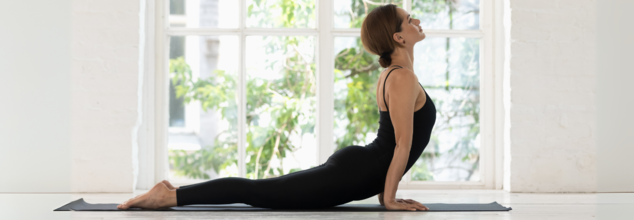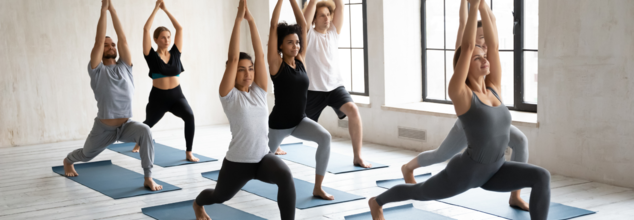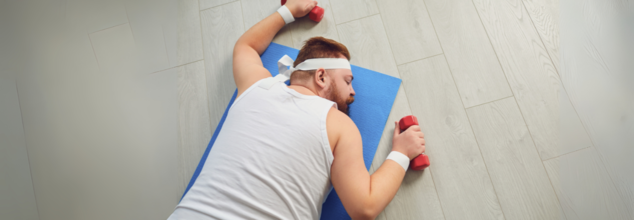
(Credit-Canva)
7 Animal-Inspired Yoga Poses And How They Affect Your Health
Yoga is one of the most inclusive exercises one can try. Whether you are a professional athlete or a beginner, yoga can accommodate all levels and help people lead a healthier life. One unique thing about yoga is that it draws from everything around us. It is adaptable and helps you in various ways. For example, despite originating hundreds of years ago, yoga, when desks jobs were not even a concept, today we have desktop yoga poses that help people who spend prolonged hours sitting.
Yoga draws from nature and helps us stay connected to all the living beings. Drawing inspirations from animals and their way of living, there are many animal-inspired yoga poses that help us a great deal. Not only do these poses help us heal our body, but it also allows us certain moments in the animal’s state of being. Here are some animal-inspired yoga poses you can try. Make sure you do them very carefully and cease any more exercising in case you are feeling any discomfort or pain. Following a professionals guide as to what breathing pattern you should follow and how to execute the yoga pose can really help.
Butterfly Pose (Baddha Konasana)
This seated pose gently opens the inner thighs, hips, and groin, boosting flexibility. It can also tone the lower body, improve digestion, and alleviate back pain by stretching and engaging lower back muscles. This pose is particularly beneficial for women's reproductive health.
Cat-Cow Pose (Marjaryasana-Bitilasana)
This dynamic flow warms up the spine, releasing tension in the back and neck, and enhancing posture and balance. It increases spinal flexibility and strengthens surrounding muscles. Additionally, it massages and stimulates abdominal organs, and provides relief from back pain.
Cobra Pose (Bhujangasana)
This rejuvenating backbend opens the chest, shoulder blades, neck, and collarbones. It improves spinal posture and reduces stress. By enhancing blood circulation, it can also alleviate back pain and inflammation related to chronic conditions. Furthermore, it can contribute to a better sleep cycle.
Fish Pose (Matsyasana)
This pose offers both physical and mental benefits. It opens the chest, shoulders, and throat, counteracting the effects of prolonged sitting. It stretches chest muscles, improving lung capacity and oxygen intake. It also relieves tension in the neck and shoulders.
Downward Dog Pose (Adho Mukha Svanasana)
A staple in many yoga sequences, this pose builds core strength and provides a full-body stretch, strengthening muscles in the arms and legs. It's excellent for bone strengthening, spinal tension relief, and overall flexibility improvement.
Camel Pose (Ustrasana)
This backbend stretches the entire front of the body, including the chest, abdomen, and quadriceps, while improving spinal flexibility. It stimulates abdominal and neck organs and aids digestion. It also strengthens quadriceps and tones glutes, but those with sensitive knees should exercise caution.
Eagle Pose (Garudasana)
This pose enhances balance, coordination, and concentration by engaging multiple muscle groups. It stretches the shoulders, upper back, and thighs, promoting flexibility and mobility. It also fosters calmness and focus, reducing stress and anxiety while improving mind-body awareness.

(Credit-Canva)
What Happens To Your Body When You Do Surya Namaskar Everyday
Surya namaskar is a series of yogic poses practiced as a tribute to the sun, giver of life. Practicing Surya namaskar before any routine activity during your day helps you feel energized and focused all day long. According to the Journal of Ayurveda and Integrative Medicine 2021 edition, Surya namaskar was endorsed by yogic figures like the Raja of Aundh, T Krishnamacharya, and various other yoga schools, promoting this series of poses for good health and overall wellness.
Suryanamaskar combines physical postures with specific breathing techniques, which gives you an integrative experience of asanas and pranayama. Done in 24 rounds, surya namaskar has 12 poses that you do, along with chants. Doing these focused poses, concentrating on your breathing and posture helps you build a good physical and mental health. These are like building blocks for your yoga journey, that focuses on whole body wellness. Once you start doing this everyday, you will notice some welcome changes to your body.
You Will Be Stronger And More Flexible
The poses in Surya Namaskar work many muscles. When you do them everyday, you will notice how your shaky moves soon become focused as your muscles get toned. Regular movement stretches your body, which then makes you more flexible. This helps your joints move better and makes everyday activities easier. You'll feel more agile and less stiff.
You Will Have Better Heart Health
To have a healthy heart, you need to work it out too. Moving through the Surya Namaskar sequence raises your heart rate, giving your heart a gentle workout. This improves blood flow throughout your body. Doing it regularly can help your heart stay healthy and strong, and it can help prevent heart related illnesses.
You Will Be Able To Manage Your Weight
Surya Namaskar helps burn calories, which helps you lose weight or maintain a healthy weight. It also boosts your metabolism, so your body burns energy more efficiently. Plus, it tones your muscles, which can help you look and feel fitter.
Your Digestion Will Improve
The poses that stretch and compress your belly help your digestive system work better. This can ease problems like constipation and help your body absorb nutrients from food more effectively. You'll feel less bloated and more comfortable.
Your Hormones Will Be Balanced
Surya Namaskar is thought to help balance your hormones, which affect your mood and energy levels. Regular practice can help your body produce the right amount of hormones, leading to a more stable mood and increased vitality.
You Will Have Less Stress And Mental Clarity
The deep breathing and flowing movements in Surya Namaskar help you relax. This can reduce stress and anxiety. It also helps you focus better and feel more calm and peaceful. Your mind will feel clearer and more at ease.
You Will Have Improved Blood Circulation And Skin Health
Surya Namaskar increases blood flow, delivering more oxygen and nutrients to your skin. This can give your skin a healthy glow. Good circulation also helps remove toxins, keeping your skin clear and healthy.
Your Bones Will Be Stronger
Because surya namaskar uses your own body weight, it helps to strengthen your bones over time. Stronger bones help prevent problems like osteoporosis, especially as you get older. This means you’ll maintain better bone health.

(Credit-Canva)
Stop Exercising Immediately If You Notice These Signs
Exercising is a great habit one should adopt. Not only does it help people better their health, but it also help them gain self-confidence, better mental health etc. World Health Organization (WHO) statistics show that people who are inactive often face 20% to 30% increased risk of death compared to people who are regularly active. This doesn’t mean one must spend long hours exercising, the American Heart Association recommends 150 minutes of moderate-intensity exercise per week, and for vigorous intensity exercise, it is 75 minutes per week.
So, how can something that improves the quality of our lives be so detrimental that we must stop doing it?
You Could Be Overdoing Your Exercises
While exercising is very good for your body, if not done right it can injure you. There are many factors one must consider when it comes to exercising.
it's crucial to recognize that there's a limit to how much exercise is beneficial. MedlinePlus exceeding this limit can lead to overtraining and adverse effects. Experts explain early signs of overtraining include a decline in progress or results, persistent fatigue, muscle soreness, and sleep disturbances. These symptoms indicate that the body is under excessive stress.
Despite all the benefits of exercising, there are times when you must stop exercising. Here are some signs of overtraining according to the National Academy of Sports Management.
Elevated Heart Rate That Doesn't Decrease With Rest
Watch your heart rate during workouts. If your heart stays high or beats unevenly when you rest, stop exercising. A heart rate that doesn't slow down means your body is stressed, and you should stop and rest.
Sudden Shortness of Breath
Know the difference between normal exercise breathing and unusual shortness of breath. If you suddenly can't breathe during an easy activity, stop. Sudden breathlessness can indicate a problem. See a doctor if it happens.
Dizziness
Feeling dizzy while exercising could mean you're pushing too hard or dehydrated. If dizziness continues after resting and drinking water, or if you feel confused or faint, get medical help. Dizziness is a sign to stop and check what's wrong.
Leg Cramps
Leg cramps during exercise might signal circulation problems or dehydration. Cramps can also be caused by low electrolytes. To relieve cramps, cool the area, stretch, and massage the muscle. If cramps are frequent, consult your doctor.
Irregular Heartbeat
If you have irregular heartbeats, like atrial fibrillation, pay close attention to your heart. If you feel fluttering or thumping in your chest, seek emergency medical care. Irregular heartbeats can be dangerous and require immediate attention.
Sudden Increase in Sweat Levels
An unexpected increase in sweating during a normal workout could mean your body is stressed. If you sweat a lot more than usual, especially when it's not hot, stop exercising. Excessive sweating can be a warning sign, so take a break and see if something is wrong.
Another Sign You Shouldn’t Ignore
Chest pain during exercise is not normal. If you feel pain or pressure in your chest, especially with nausea, dizziness, or heavy sweating, stop immediately. Chest pain can signal a serious problem, so seek medical help right away.
Safety Precautions With Exercising
Don't jump from no exercise to hard workouts. Slowly increase how long and how intense you exercise. Give your body time to adjust. Take breaks and don't push too hard too fast. Returning to exercise should be a gradual process. People who are at risk for heart disease, including those with hypertension, high cholesterol, diabetes, a history of smoking, or a family history of heart disease, should consult their doctor before starting an exercise program.

(Credit-Canva)
10 Minutes, Daily, Every Week: 8 Yoga Poses To Stay Fit And Healthy
Yoga has the ability to set the tone of your day. We see people who wake up super early, do a morning routine and squeeze in some yoga. This may seem like a hectic schedule to many, but exercising early in the morning has shown to be good for the mental as well as physical well-being of people. Experts explain that doing yoga every morning increases your energy, improves mental clarity, helps you reduce stress as well as ensure your physical well-being.
If you are worried about spending a dedicated time doing yoga, like an hour or so, you do not have to worry. Even spending 10 minutes, fully focused yoga can help you immensely. If you are doing these poses with guided videos, make sure you are not pushing yourself too hard, and proceed with caution. If you feel any odd discomfort, make sure you visit a healthcare professional just to be safe.
Child's Pose
Begin in Child's Pose, bringing your big toes together and knees wide for a comfortable stretch. Extend your arms forward, lifting onto your fingertips to deepen the stretch in your shoulders and armpits. Focus on expanding your ribcage with each inhale and relaxing your arms closer to the mat with each exhale, using your breath to settle into the pose.
Cat-Cow
Transition to Tabletop position, bringing your knees closer together. Flow through three rounds of Cat-Cow, arching your back on the inhale and rounding it on the exhale. This movement helps to gently mobilize and warm up your spine.
Leg Lifts and Variations
From Tabletop, lift your right leg, knee, and toes towards the ceiling on the inhale, and bring your knee to your nose on the exhale. Repeat twice, engaging your core. For an added challenge, lift your right leg again and reach back with your left hand to grab your right foot, deepening the backbend and stretching your left shoulder.
Modified Side Plank
With your right leg lifted, return your left hand to the mat, straighten your right leg, and roll onto the inner edge of your right foot into a modified Side Plank. Perform five toe taps, lifting and lowering your right leg, then bend your right knee to grab your right foot, deepening the backbend and shoulder stretch. Repeat the sequence on the left side.
Downward-Facing Dog
Move into Downward-Facing Dog, lifting your hips up and back, bending your knees as needed to lengthen your spine. From Down Dog, lift your right leg, bend your knee, and open your hip in Scorpion Dog.
Warrior 2 and Triangle Pose
Step your right foot forward into Warrior 2, grounding through your back foot and bending your front knee. Transition into Triangle Pose, straightening your right leg and reaching your right arm forward, then down, while your left arm extends upward. Explore variations to deepen the pose and strengthen your obliques.
Low Lunge and Quad Stretch
From Triangle Pose, move into Low Lunge, placing your back knee on the mat. Optionally, add a quad stretch by reaching back with your right hand to grab your left foot, pulling your heel towards your glutes. Repeat the sequence on the left side, then move back to Downward-Facing Dog.
Child's Pose and Seated Meditation
Return to Child's Pose, resting your hips towards your heels and extending your arms forward. Take five deep breaths, reflecting on your intention for the day. Transition into a comfortable seated position for a short meditation. Close your eyes, relax your shoulders, and soften your facial muscles. Focus on your breath and your intention for the day, grounding yourself before moving forward.
© 2024 Bennett, Coleman & Company Limited



